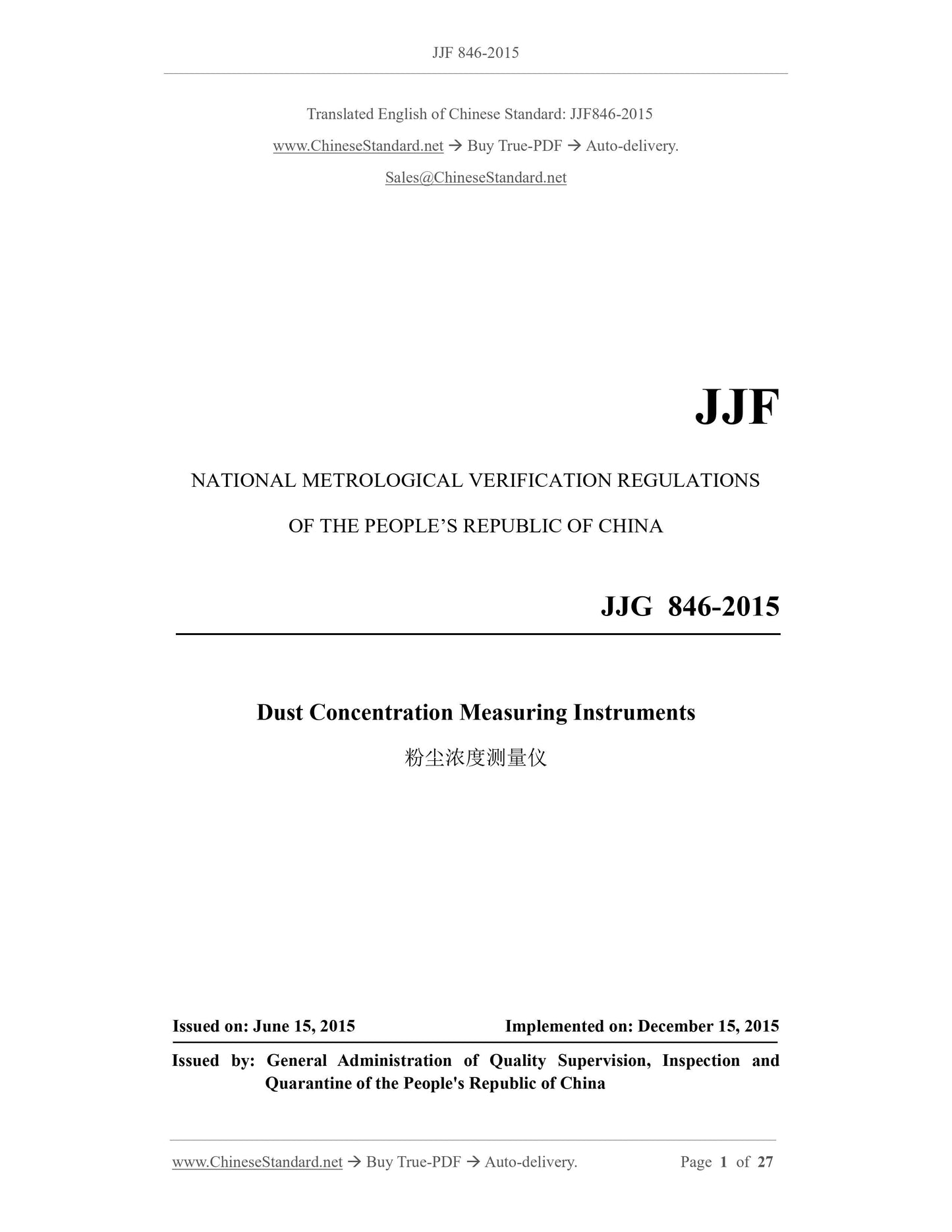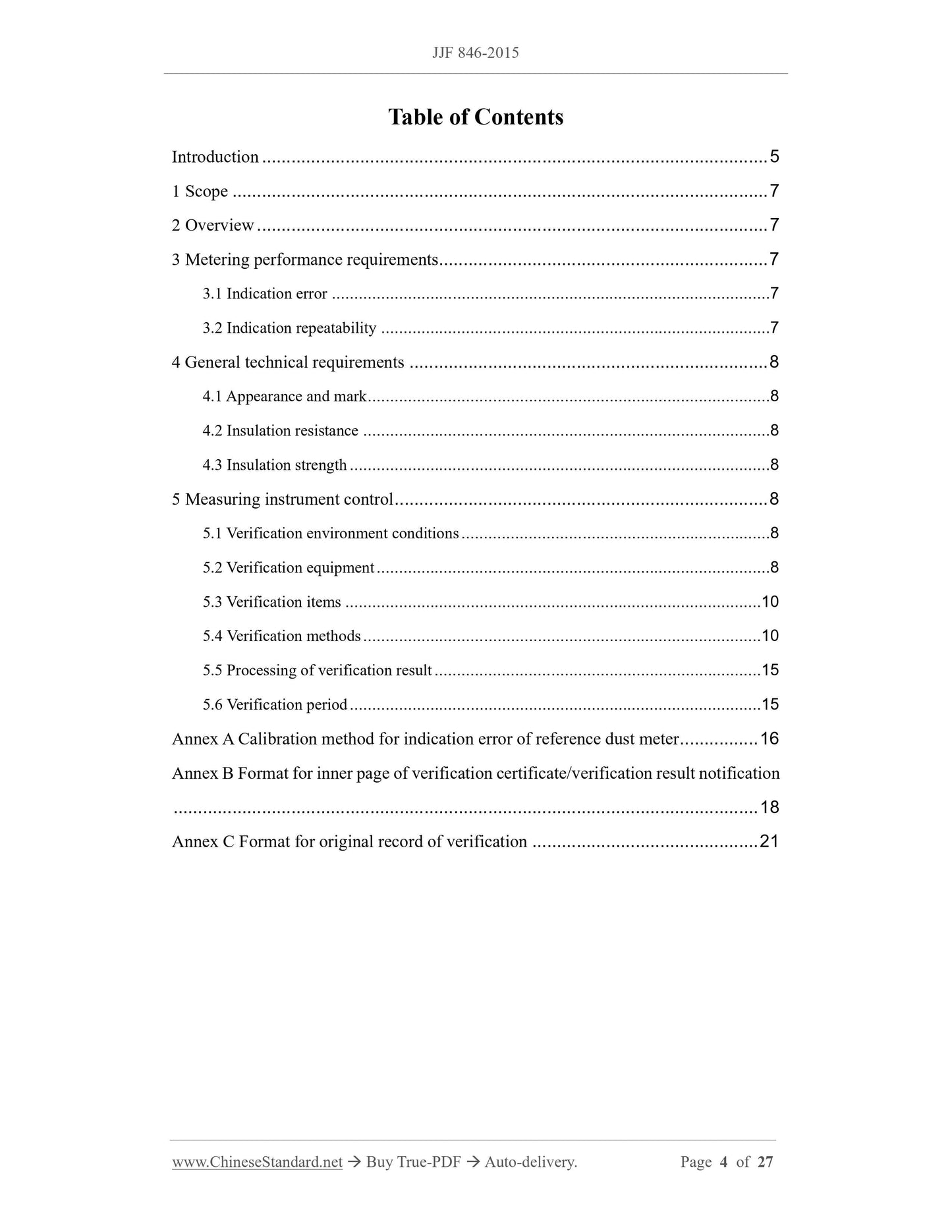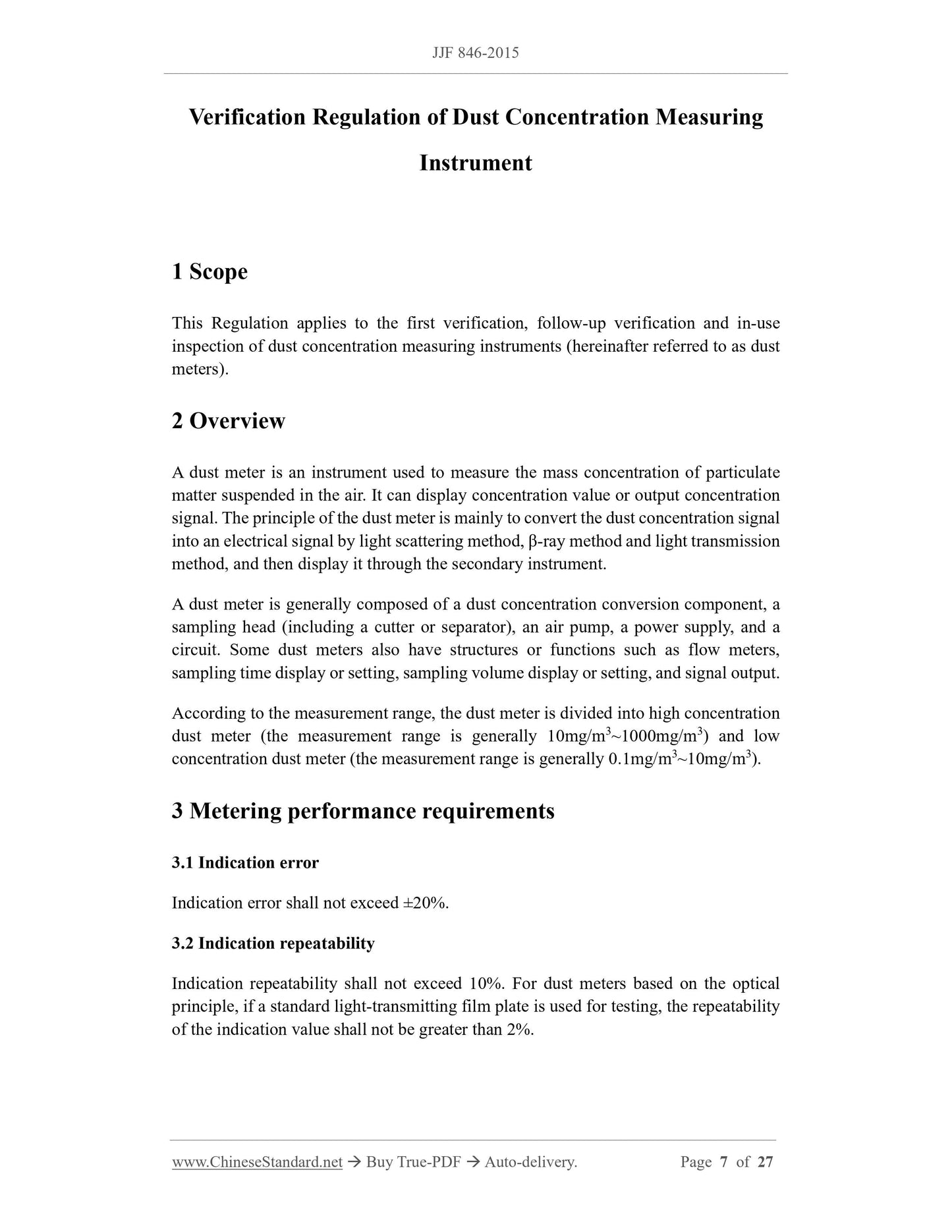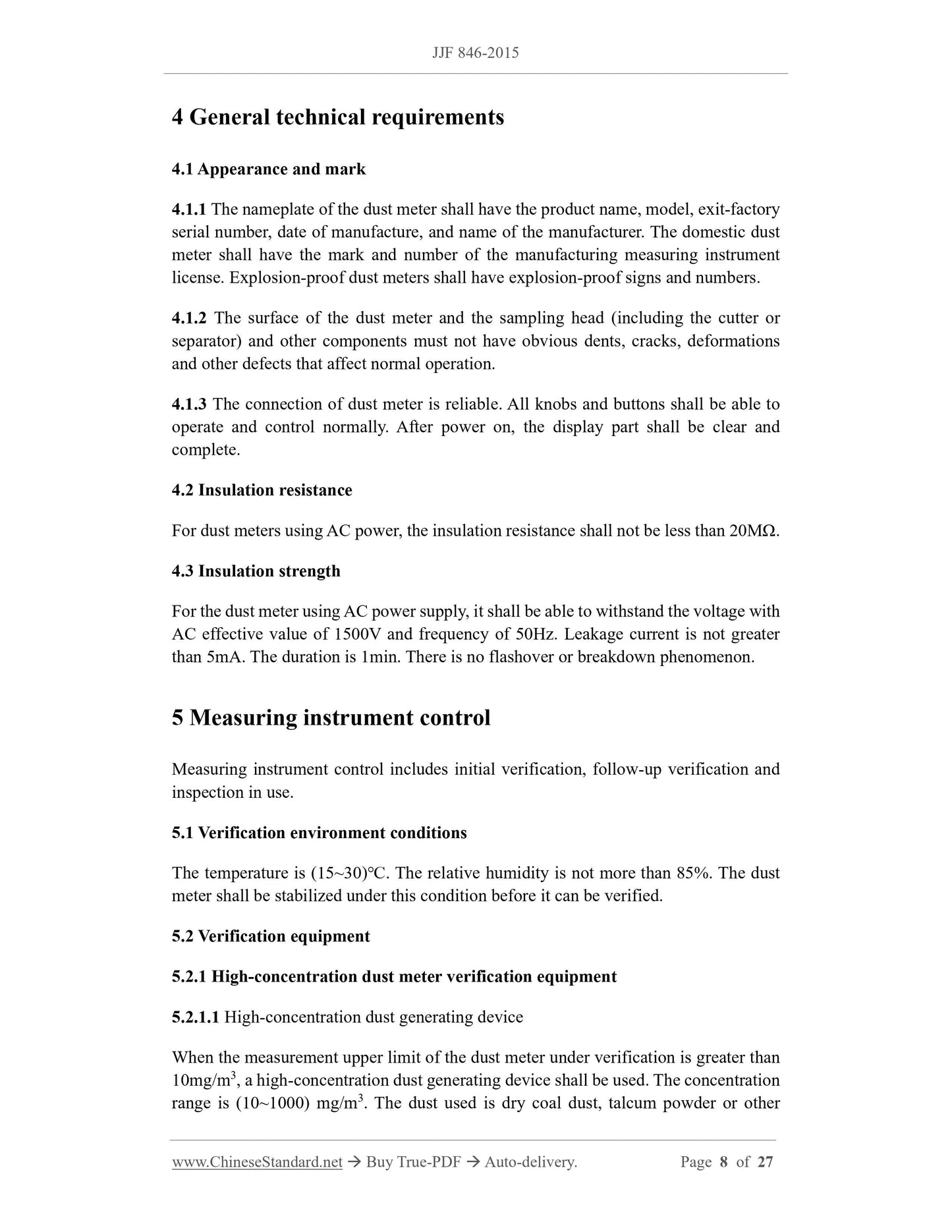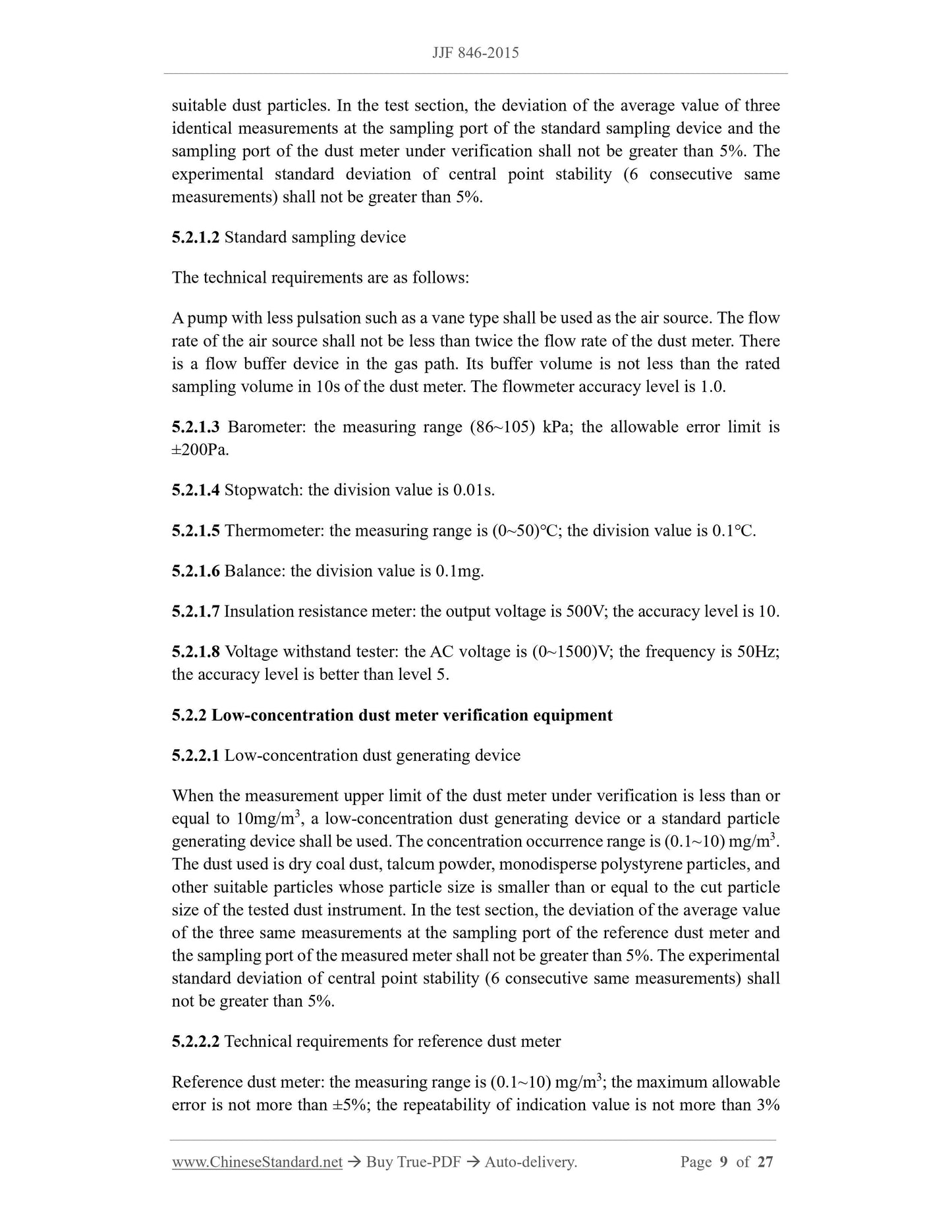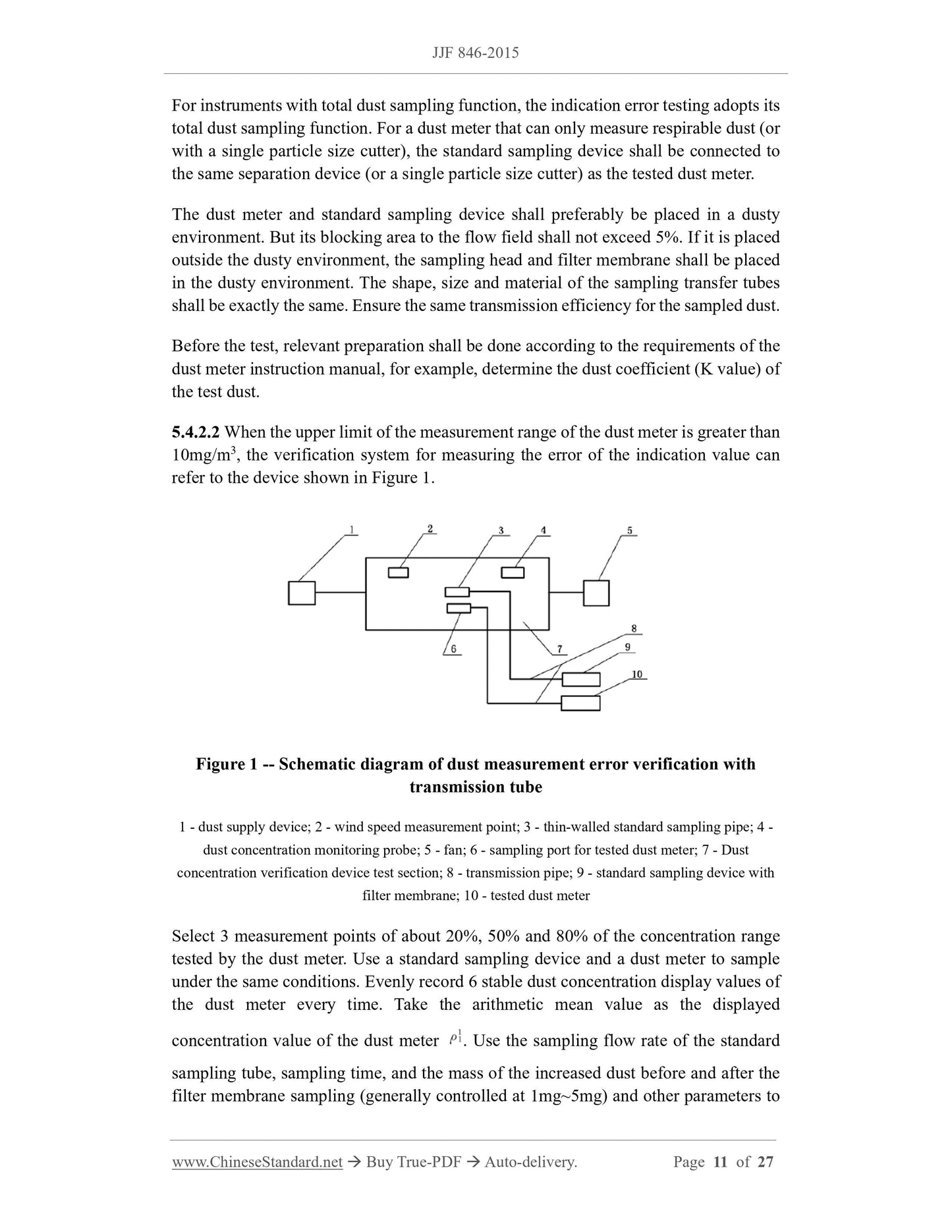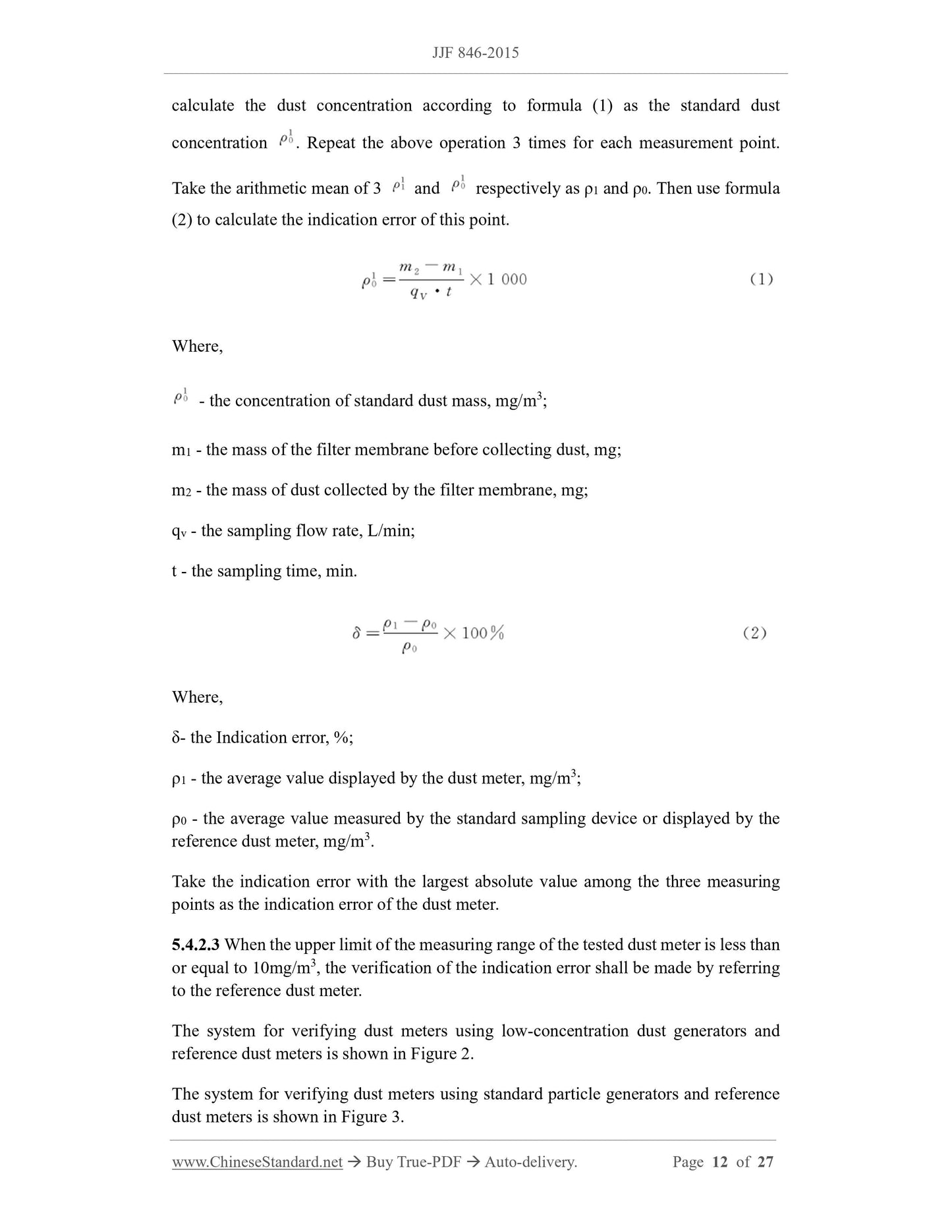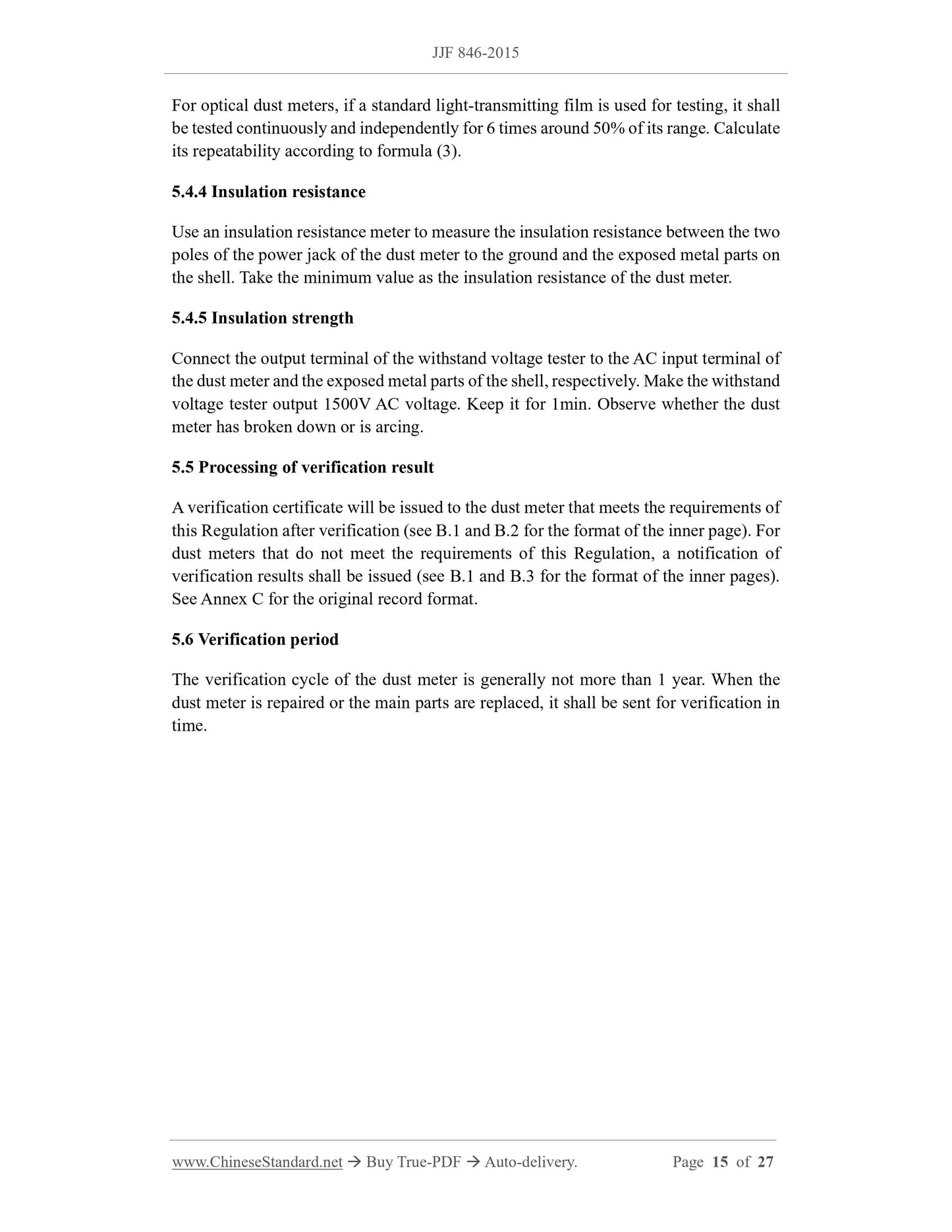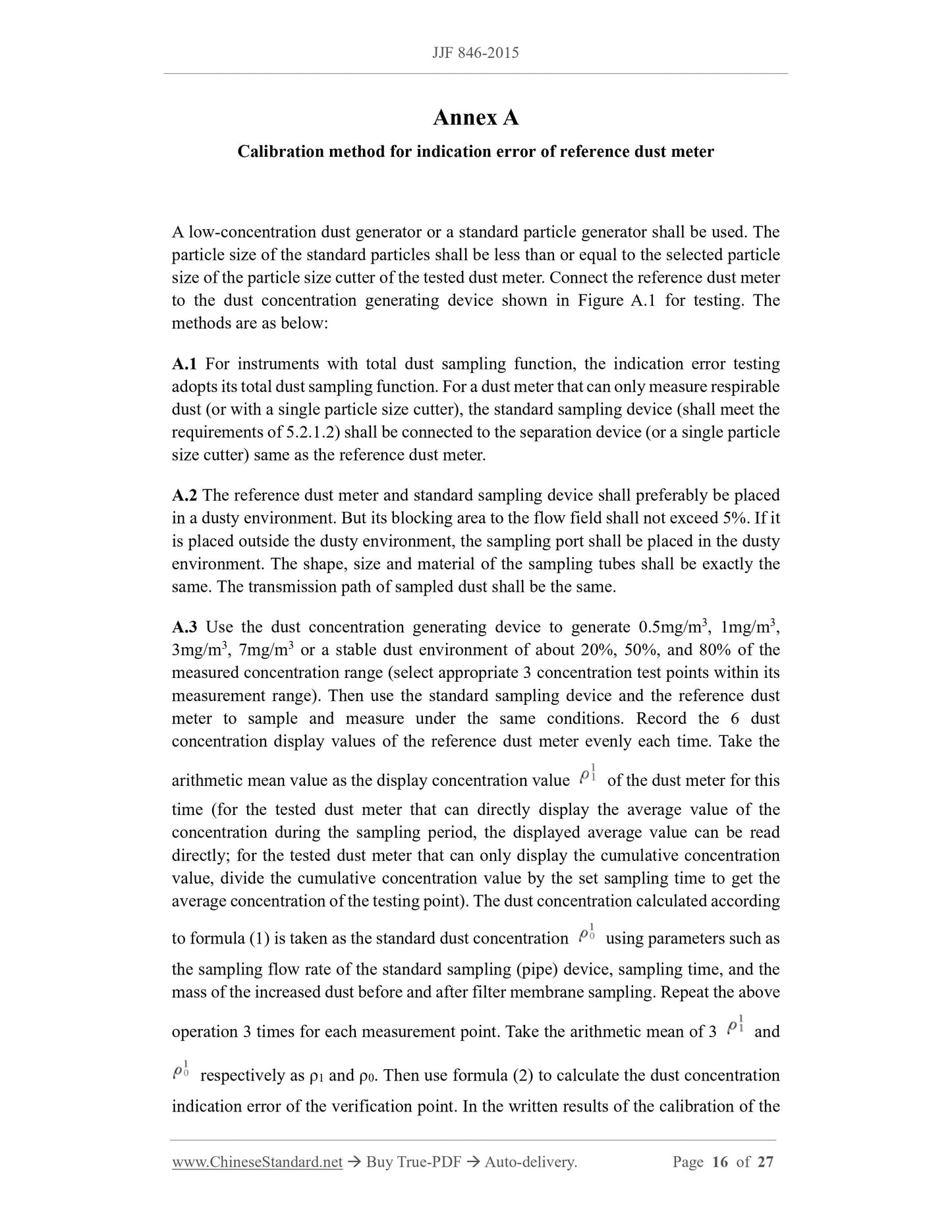1
/
of
9
PayPal, credit cards. Download editable-PDF and invoice in 1 second!
JJG 846-2015 English PDF
JJG 846-2015 English PDF
Regular price
$320.00 USD
Regular price
Sale price
$320.00 USD
Unit price
/
per
Shipping calculated at checkout.
Couldn't load pickup availability
Delivery: 3 seconds. Download true-PDF + Invoice.
Get QUOTATION in 1-minute: Click JJG 846-2015
Historical versions: JJG 846-2015
Preview True-PDF (Reload/Scroll if blank)
JJG 846-2015: Dust Concentration Measuring Instruments
JJF 846-2015
JJF
NATIONAL METROLOGICAL VERIFICATION REGULATIONS
OF THE PEOPLE’S REPUBLIC OF CHINA
JJG 846-2015
Dust Concentration Measuring Instruments
ISSUED ON: JUNE 15, 2015
IMPLEMENTED ON: DECEMBER 15, 2015
Issued by: General Administration of Quality Supervision, Inspection and
Quarantine of the People's Republic of China
Table of Contents
Introduction ... 5
1 Scope ... 7
2 Overview ... 7
3 Metering performance requirements ... 7
3.1 Indication error ... 7
3.2 Indication repeatability ... 7
4 General technical requirements ... 8
4.1 Appearance and mark ... 8
4.2 Insulation resistance ... 8
4.3 Insulation strength ... 8
5 Measuring instrument control ... 8
5.1 Verification environment conditions ... 8
5.2 Verification equipment ... 8
5.3 Verification items ... 10
5.4 Verification methods ... 10
5.5 Processing of verification result ... 15
5.6 Verification period ... 15
Annex A Calibration method for indication error of reference dust meter ... 16
Annex B Format for inner page of verification certificate/verification result notification
... 18
Annex C Format for original record of verification ... 21
Verification Regulation of Dust Concentration Measuring
Instrument
1 Scope
This Regulation applies to the first verification, follow-up verification and in-use
inspection of dust concentration measuring instruments (hereinafter referred to as dust
meters).
2 Overview
A dust meter is an instrument used to measure the mass concentration of particulate
matter suspended in the air. It can display concentration value or output concentration
signal. The principle of the dust meter is mainly to convert the dust concentration signal
into an electrical signal by light scattering method, β-ray method and light transmission
method, and then display it through the secondary instrument.
A dust meter is generally composed of a dust concentration conversion component, a
sampling head (including a cutter or separator), an air pump, a power supply, and a
circuit. Some dust meters also have structures or functions such as flow meters,
sampling time display or setting, sampling volume display or setting, and signal output.
According to the measurement range, the dust meter is divided into high concentration
dust meter (the measurement range is generally 10mg/m3~1000mg/m3) and low
concentration dust meter (the measurement range is generally 0.1mg/m3~10mg/m3).
3 Metering performance requirements
3.1 Indication error
Indication error shall not exceed ±20%.
3.2 Indication repeatability
Indication repeatability shall not exceed 10%. For dust meters based on the optical
principle, if a standard light-transmitting film plate is used for testing, the repeatability
of the indication value shall not be greater than 2%.
4 General technical requirements
4.1 Appearance and mark
4.1.1 The nameplate of the dust meter shall have the product name, model, exit-factory
serial number, date of manufacture, and name of the manufacturer. The domestic dust
meter shall have the mark and number of the manufacturing measuring instrument
license. Explosion-proof dust meters shall have explosion-proof signs and numbers.
4.1.2 The surface of the dust meter and the sampling head (including the cutter or
separator) and other components must not have obvious dents, cracks, deformations
and other defects that affect normal operation.
4.1.3 The connection of dust meter is reliable. All knobs and buttons shall be able to
operate and control normally. After power on, the display part shall be clear and
complete.
4.2 Insulation resistance
For dust meters using AC power, the insulation resistance shall not be less than 20MΩ.
4.3 Insulation strength
For the dust meter using AC power supply, it shall be able to withstand the voltage with
AC effective value of 1500V and frequency of 50Hz. Leakage current is not greater
than 5mA. The duration is 1min. There is no flashover or breakdown phenomenon.
5 Measuring instrument control
Measuring instrument control includes initial verification, follow-up verification and
inspection in use.
5.1 Verification environment conditions
The temperature is (15~30)℃. The relative humidity is not more than 85%. The dust
meter shall be stabilized under this condition before it can be verified.
5.2 Verification equipment
5.2.1 High-concentration dust meter verification equipment
5.2.1.1 High-concentration dust generating device
When the measurement upper limit of the dust meter under verification is greater than
10mg/m3, a high-concentration dust generating device shall be used. The concentration
range is (10~1000) mg/m3. The dust used is dry coal dust, talcum powder or other
suitable dust particles. In the test section, the deviation of the average value of three
identical measurements at the sampling port of the standard sampling device and the
sampling port of the dust meter under verification shall not be greater than 5%. The
experimental standard deviation of central point stability (6 consecutive same
measurements) shall not be greater than 5%.
5.2.1.2 Standard sampling device
The technical requirements are as follows:
A pump with less pulsation such as a vane type shall be used as the air source. The flow
rate of the air source shall not be less than twice the flow rate of the dust meter. There
is a flow buffer device in the gas path. Its buffer volume is not less than the rated
sampling volume in 10s of the dust meter. The flowmeter accuracy level is 1.0.
5.2.1.3 Barometer: the measuring range (86~105) kPa; the allowable error limit is
±200Pa.
5.2.1.4 Stopwatch: the division value is 0.01s.
5.2.1.5 Thermometer: the measuring range is (0~50)℃; the division value is 0.1℃.
5.2.1.6 Balance: the division value is 0.1mg.
5.2.1.7 Insulation resistance meter: the output voltage is 500V; the accuracy level is 10.
5.2.1.8 Voltage withstand tester: the AC voltage is (0~1500)V; the frequency is 50Hz;
the accuracy level is better than level 5.
5.2.2 Low-concentration dust meter verification equipment
5.2.2.1 Low-concentration dust generating device
When the measurement upper limit of the dust meter under verification is less than or
equal to 10mg/m3, a low-concentration dust generating device or a standard particle
generating device shall be used. The concentration occurrence range is (0.1~10) mg/m3.
The dust used is dry coal dust, talcum powder, monodisperse polystyrene particles, and
other suitable particles whose particle size is smaller than or equal to the cut particle
size of the tested dust instrument. In the test section, the deviation of the average value
of the three same measurements at the sampling port of the reference dust meter and
the sampling port of the measured meter shall not be greater than 5%. The experimental
standard deviation of central point stability (6 consecutive same measurements) shall
not be greater than 5%.
5.2.2.2 Technical requirements for reference dust meter
Reference dust meter: the measuring range is (0.1~10) mg/m3; the maximum allowable
error is not more than ±5%; the repeatability of indication value is not more than 3%
For instruments with total dust sampling function, the indication error testing adopts its
total dust sampling function. For a dust meter that can only measure respirable dust (or
with a single particle size cutter), the standard sampling device shall be connected to
the same separation device (or a single particle s...
Get QUOTATION in 1-minute: Click JJG 846-2015
Historical versions: JJG 846-2015
Preview True-PDF (Reload/Scroll if blank)
JJG 846-2015: Dust Concentration Measuring Instruments
JJF 846-2015
JJF
NATIONAL METROLOGICAL VERIFICATION REGULATIONS
OF THE PEOPLE’S REPUBLIC OF CHINA
JJG 846-2015
Dust Concentration Measuring Instruments
ISSUED ON: JUNE 15, 2015
IMPLEMENTED ON: DECEMBER 15, 2015
Issued by: General Administration of Quality Supervision, Inspection and
Quarantine of the People's Republic of China
Table of Contents
Introduction ... 5
1 Scope ... 7
2 Overview ... 7
3 Metering performance requirements ... 7
3.1 Indication error ... 7
3.2 Indication repeatability ... 7
4 General technical requirements ... 8
4.1 Appearance and mark ... 8
4.2 Insulation resistance ... 8
4.3 Insulation strength ... 8
5 Measuring instrument control ... 8
5.1 Verification environment conditions ... 8
5.2 Verification equipment ... 8
5.3 Verification items ... 10
5.4 Verification methods ... 10
5.5 Processing of verification result ... 15
5.6 Verification period ... 15
Annex A Calibration method for indication error of reference dust meter ... 16
Annex B Format for inner page of verification certificate/verification result notification
... 18
Annex C Format for original record of verification ... 21
Verification Regulation of Dust Concentration Measuring
Instrument
1 Scope
This Regulation applies to the first verification, follow-up verification and in-use
inspection of dust concentration measuring instruments (hereinafter referred to as dust
meters).
2 Overview
A dust meter is an instrument used to measure the mass concentration of particulate
matter suspended in the air. It can display concentration value or output concentration
signal. The principle of the dust meter is mainly to convert the dust concentration signal
into an electrical signal by light scattering method, β-ray method and light transmission
method, and then display it through the secondary instrument.
A dust meter is generally composed of a dust concentration conversion component, a
sampling head (including a cutter or separator), an air pump, a power supply, and a
circuit. Some dust meters also have structures or functions such as flow meters,
sampling time display or setting, sampling volume display or setting, and signal output.
According to the measurement range, the dust meter is divided into high concentration
dust meter (the measurement range is generally 10mg/m3~1000mg/m3) and low
concentration dust meter (the measurement range is generally 0.1mg/m3~10mg/m3).
3 Metering performance requirements
3.1 Indication error
Indication error shall not exceed ±20%.
3.2 Indication repeatability
Indication repeatability shall not exceed 10%. For dust meters based on the optical
principle, if a standard light-transmitting film plate is used for testing, the repeatability
of the indication value shall not be greater than 2%.
4 General technical requirements
4.1 Appearance and mark
4.1.1 The nameplate of the dust meter shall have the product name, model, exit-factory
serial number, date of manufacture, and name of the manufacturer. The domestic dust
meter shall have the mark and number of the manufacturing measuring instrument
license. Explosion-proof dust meters shall have explosion-proof signs and numbers.
4.1.2 The surface of the dust meter and the sampling head (including the cutter or
separator) and other components must not have obvious dents, cracks, deformations
and other defects that affect normal operation.
4.1.3 The connection of dust meter is reliable. All knobs and buttons shall be able to
operate and control normally. After power on, the display part shall be clear and
complete.
4.2 Insulation resistance
For dust meters using AC power, the insulation resistance shall not be less than 20MΩ.
4.3 Insulation strength
For the dust meter using AC power supply, it shall be able to withstand the voltage with
AC effective value of 1500V and frequency of 50Hz. Leakage current is not greater
than 5mA. The duration is 1min. There is no flashover or breakdown phenomenon.
5 Measuring instrument control
Measuring instrument control includes initial verification, follow-up verification and
inspection in use.
5.1 Verification environment conditions
The temperature is (15~30)℃. The relative humidity is not more than 85%. The dust
meter shall be stabilized under this condition before it can be verified.
5.2 Verification equipment
5.2.1 High-concentration dust meter verification equipment
5.2.1.1 High-concentration dust generating device
When the measurement upper limit of the dust meter under verification is greater than
10mg/m3, a high-concentration dust generating device shall be used. The concentration
range is (10~1000) mg/m3. The dust used is dry coal dust, talcum powder or other
suitable dust particles. In the test section, the deviation of the average value of three
identical measurements at the sampling port of the standard sampling device and the
sampling port of the dust meter under verification shall not be greater than 5%. The
experimental standard deviation of central point stability (6 consecutive same
measurements) shall not be greater than 5%.
5.2.1.2 Standard sampling device
The technical requirements are as follows:
A pump with less pulsation such as a vane type shall be used as the air source. The flow
rate of the air source shall not be less than twice the flow rate of the dust meter. There
is a flow buffer device in the gas path. Its buffer volume is not less than the rated
sampling volume in 10s of the dust meter. The flowmeter accuracy level is 1.0.
5.2.1.3 Barometer: the measuring range (86~105) kPa; the allowable error limit is
±200Pa.
5.2.1.4 Stopwatch: the division value is 0.01s.
5.2.1.5 Thermometer: the measuring range is (0~50)℃; the division value is 0.1℃.
5.2.1.6 Balance: the division value is 0.1mg.
5.2.1.7 Insulation resistance meter: the output voltage is 500V; the accuracy level is 10.
5.2.1.8 Voltage withstand tester: the AC voltage is (0~1500)V; the frequency is 50Hz;
the accuracy level is better than level 5.
5.2.2 Low-concentration dust meter verification equipment
5.2.2.1 Low-concentration dust generating device
When the measurement upper limit of the dust meter under verification is less than or
equal to 10mg/m3, a low-concentration dust generating device or a standard particle
generating device shall be used. The concentration occurrence range is (0.1~10) mg/m3.
The dust used is dry coal dust, talcum powder, monodisperse polystyrene particles, and
other suitable particles whose particle size is smaller than or equal to the cut particle
size of the tested dust instrument. In the test section, the deviation of the average value
of the three same measurements at the sampling port of the reference dust meter and
the sampling port of the measured meter shall not be greater than 5%. The experimental
standard deviation of central point stability (6 consecutive same measurements) shall
not be greater than 5%.
5.2.2.2 Technical requirements for reference dust meter
Reference dust meter: the measuring range is (0.1~10) mg/m3; the maximum allowable
error is not more than ±5%; the repeatability of indication value is not more than 3%
For instruments with total dust sampling function, the indication error testing adopts its
total dust sampling function. For a dust meter that can only measure respirable dust (or
with a single particle size cutter), the standard sampling device shall be connected to
the same separation device (or a single particle s...
Share
